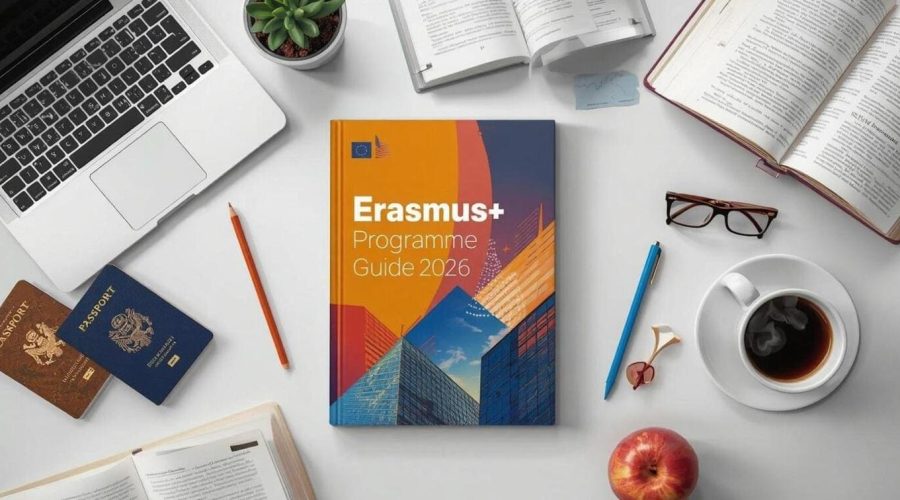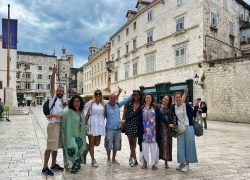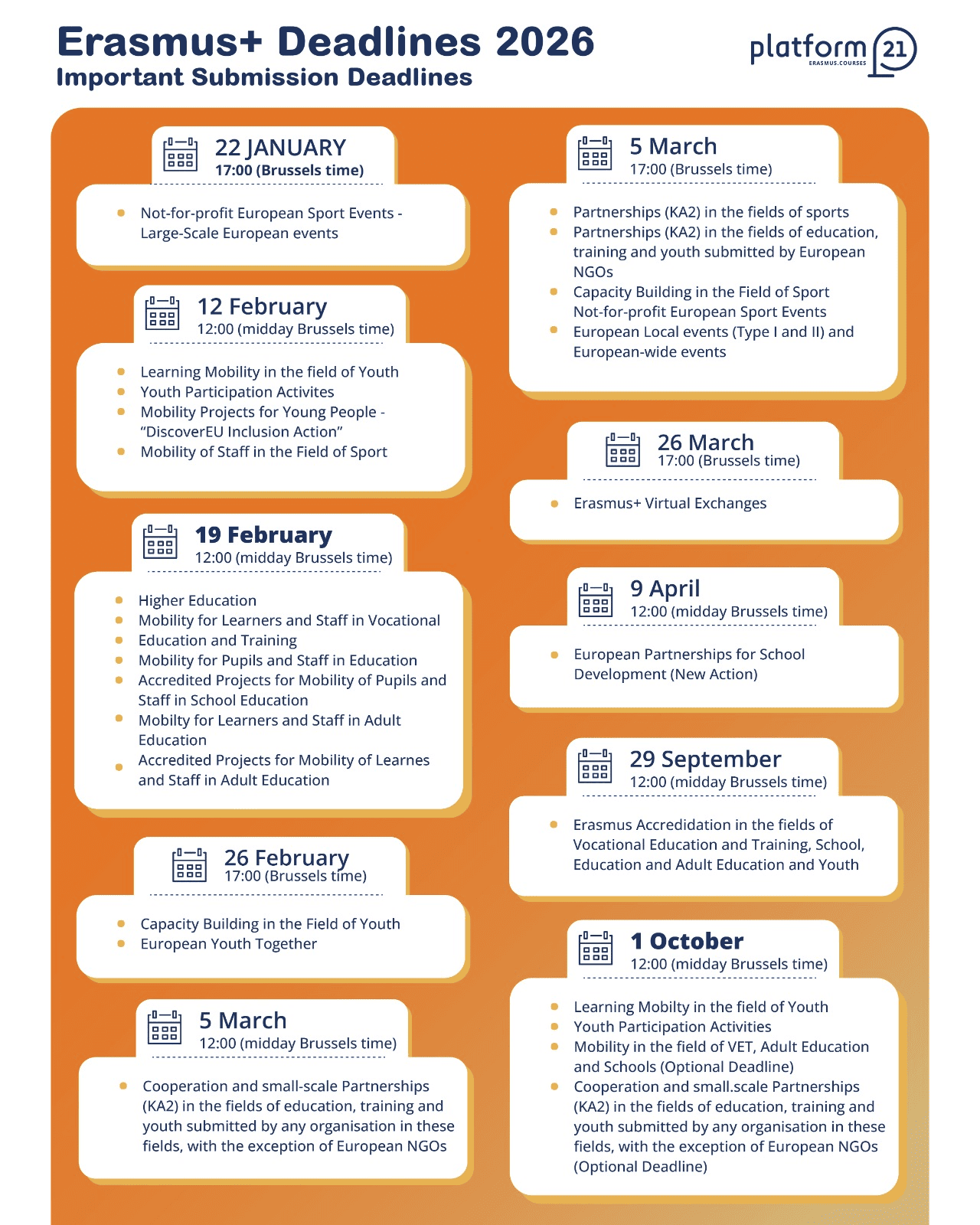Erasmus+ 2026 Programme Guide: Key Changes, KA1 & KA2 Deadlines

We checked what stayed the same, what changed for 2026, and which parts you really need to care about. In this blog, we bring you the main new elements plus the key KA1 and KA2 application deadlines for 2026.
Erasmus+ 2026 in a nutshell
On 12 November 2025, the European Commission opened the Erasmus+ 2026 call for proposals, with a budget of around €5.2 billion for the year.
The programme still follows the same four big priorities (no surprises here):
- Inclusion and Diversity – make sure learners with fewer opportunities can really take part.
- Digital Transformation – digital skills, AI in education, and smart use of online tools.
- Environment and Fight Against Climate Change – green competences and sustainable behaviour.
- Participation in Democratic Life – civic engagement, media literacy, EU values.
The key message for learning mobility (KA1) in 2026 is clear:
Mobility must be inclusive, green and digital – not only in words, but in real project design and budget.
Good news for schools and organisations: there is no “big revolution” this year. The overall structure from the 2025 Guide stays the same. But inside the details, there are important changes that can help or hurt your application score.
What stayed the same from 2025 to 2026?
Before we jump to the novelties, let’s calm the nerves:
- Key Actions are the same: KA1 (mobility), KA2 (cooperation), KA3 (policy), plus Jean Monnet.
- Main project types continue:
- KA121 (accredited mobility), KA122 (short-term mobility),
- KA2 Cooperation Partnerships and Small-scale Partnerships, etc.
- Most duration rules and budget logic for KA1 mobilities did not change (length of mobilities, main unit costs, structure of short-term vs. accredited projects).
- The famous rules like “organisation must be legally established for at least two years” and limits on number of KA2 applications also stay.
So you do not need to redesign your whole Erasmus+ strategy.
But you do need to adjust your project logic, application text and budget to match the new priorities and evaluation criteria.

What’s really new in the 2026 Programme Guide?
The 2026 Guide brings several important upgrades compared to 2025. These are the ones you should build into your next project.
1. Mental health is now explicit – not “somewhere between the lines”
In 2025, wellbeing and mental health were often “hidden” inside inclusion or general quality of learning.
In 2026, the Guide is much more direct: school and VET projects are expected to address mental health and wellbeing, including:
- social-emotional learning (SEL)
- prevention of cyber-bullying
- safe digital behaviour
- psychological safety at school
👉 What this means for your project:
If your KA1 or KA2 project talks about “wellbeing” only in one vague sentence, that is no longer enough. Show:
- Where mental health fits in your needs analysis,
- What activities you will do (workshops, tools, training, policies),
- How you will know it made a difference (surveys, feedback, observation).
2. Girls in STEM – no more generic “gender balance” sentences
The 2026 Guide goes further with gender equality in STEM. “We will encourage girls to join STEM” is not sufficient anymore. You are expected to show:
- Baseline data – e.g. how many girls currently choose STEM subjects or VET profiles,
- Concrete interventions – mentoring, clubs, role models, curriculum changes, campaigns,
- Measurement tools – what you will track (interest, participation, future choices).
👉 If you submit a STEM-related project, make sure the “girls in STEM” part is specific and measurable, not just a slogan.
3. Green travel under 500 km – trains first, planes later
In 2026, the green dimension is sharper. The rule of thumb is:
Under 500 km = train or other green travel is the default.
You can still fly, but you need a good explanation. Your choice of transport now influences the relevance and quality scores, not only the budget.
👉 Practical tip for mobility projects:
- Plan train routes and combinations (train + bus) whenever possible.
- Use the “green travel” budget options correctly.
- If you must fly (e.g. from an island), explain clearly why.
4. Inclusion and diversity: higher weight in scoring
Inclusion and diversity are not only nice words in the introduction anymore. In the 2026 Guide:
- Projects that clearly target participants with fewer opportunities receive stronger relevance scores.
- This includes financial barriers, geographical obstacles, migrant background, special educational needs, etc.
There is also an important technical detail in KA1:
- Inclusion support for participants (extra costs for participants with fewer opportunities) is treated separately from the 50% cap on course fees and trainings.
👉 That means you can plan stronger support measures for disadvantaged participants without “eating” your training budget.
5. New KA2 action:
European Partnerships for School Development (EPSD)
One of the most interesting additions in 2026 is a new KA2 action:
European Partnerships for School Development (EPSD).
These projects are designed to help schools:
- integrate transnational activities (mobilities, exchanges) into the regular life of the school,
- develop “mobility windows” in the school year,
- create stable networks for teacher and pupil exchanges,
- test and share new teaching methods and basic skills strategies across borders.
EPSD is like a bridge between “classic” Cooperation Partnerships and the daily work of schools.
👉 If your school has already done KA1 projects and is ready for deeper, more structural change, EPSD can be a natural next step.
6. Union of Skills & Preparedness Union Strategy – the bigger picture
The 2026 Guide connects Erasmus+ more strongly with two EU-level strategies:
- Union of Skills – focus on skills for quality jobs, lifelong learning, and cooperation with employers.
- Preparedness Union Strategy – building resilient education systems able to react to crises (health, war, climate).
For you, this means:
- Projects that support skills for the green and digital transition,
- or increase the resilience of schools and organisations (e.g. digital contingency plans, mental health strategies, crisis communication)
will look even stronger in 2026.
7. CBHE: three strands and STEM Skills Foundries
For higher education and partner-country cooperation (CBHE – Capacity Building in Higher Education), the 2026 Guide introduces a clearer three-strand structure, including a new Strand 3 focused on:
- STEM Skills Foundries – entrepreneurship, intellectual property management, access to venture capital, etc.
- Deadline for this action: 10 March 2026 (managed centrally by EACEA, not National Agencies).
Even if you are mostly in school education, this shows the same direction: skills, innovation, entrepreneurship and STEM are central to Erasmus+ 2026.
8. Micro-credentials and individual VET support
Two more important points, especially for VET and adult education:
- Micro-credentials are now clearly promoted – short, flexible learning units that can be recognised and stacked.
- Individual support for VET learners is newly included, with specific unit costs depending on the country group.
This gives VET schools more tools to design flexible, learner-centred mobility.
KA1 & KA2 deadlines for 2026 (school, VET, adult, HE)
Dates may look slightly different on various national websites, but they all follow the EU Call for Proposals 2026. Based on the official information and National Agency summaries:
KA1 – Learning Mobility of Individuals (school, VET, HE, adult education)
- Main deadline for KA1 (learning mobility in education and training):
👉 19 February 2026, 12:00 (midday) Brussels time
This applies to:
- KA121 (accredited mobility projects)
- KA122 (short-term mobility projects)
in school education, adult education, VET and higher education.
(Some National Agencies may also run a second round for youth or other fields in October, but this is decided at national level.)
KA2 – Cooperation Partnerships
- Main deadline for KA2 Cooperation Partnerships and Small-scale Partnerships in education and training:
👉 5 March 2026, 12:00 (midday) Brussels time
- Some National Agencies may offer a second call for Small-scale Partnerships (usually with a deadline around 1 October 2026), especially in the youth field.
👉 Always check the website of your National Agency to confirm if a second round is available in your country.
“So what do we actually need to change in our draft?”
Here is a simple checklist you can use when updating your KA1 or KA2 application for 2026:
-
Mental health and wellbeing
- Do we show where wellbeing fits into our needs?
- Are there clear activities (not just one sentence)?
- Do we say how we will measure progress?
-
Inclusion and diversity
- Do we clearly define participants with fewer opportunities?
- Have we used inclusion support in the budget where it makes sense?
- Is inclusion visible in mobility planning, not only in the introduction?
-
Green travel
- Are mobilities under 500 km planned by train/green transport?
- If we use flights, have we explained why?
- Did we use “green travel” options in the budget correctly?
-
Girls in STEM (for STEM projects)
- Do we have baseline data (even simple school statistics)?
- Have we planned specific actions for girls?
- Do we explain how we will track change?
-
KA2 strategy (including EPSD)
- Are we ready for a deeper, long-term partnership like European Partnerships for School Development?
- Do we link our project to Union of Skills (skills for work, green and digital) or Preparedness Union (resilience, crisis readiness)?
-
Deadlines
- Is our internal planning aligned with:
- 19 February 2026 – KA1
- 5 March 2026 – KA2
Have we left time for partner feedback and last checks?
And finally – how we can help
At Platform21 – Erasmus+ Courses, we work with teachers, principals and coordinators every day. We read the Programme Guide, the Annual Work Programme, and the small print so that you can focus on your learners.
In our courses and invited-expert visits we:
- translate EU priorities (inclusion, digital, green, democratic participation) into real classroom practice,
- connect AI, soft skills and innovative methods with Erasmus+ project goals,
- help schools think beyond one project – towards long-term development.
If you want support to:
- update your KA121/KA122 mobility plan for 2026,
- design a strong KA2 Cooperation Partnership or European Partnership for School Development,
- or simply understand what these new rules mean for your school,
you are welcome to join our courses in Split, Zagreb or Reykjavik, or contact us for tailor-made support.
Erasmus+ 2026 is not a completely new game – but the rules are sharper.
If you adjust your project now, you will not only pass the evaluation – you will also make the programme’s priorities truly visible in your daily school life.
Still need more information? Contact us directly: info@erasmus.courses

Content
Tags
You may also like:

How to write a successful Erasmus+ project proposal (KA121/KA122)

Inside Iceland’s Education System: Trust, Nature, Clarity

Erasmus+ Programme 2028 – 2034 proposal: What to expect

A teacher training course in Iceland: A week to remember in Reykjavik

Erasmus+ Teacher Training Mobility with Platform21- Top 5 Reasons Why Croatia Is a Hidden Gem

